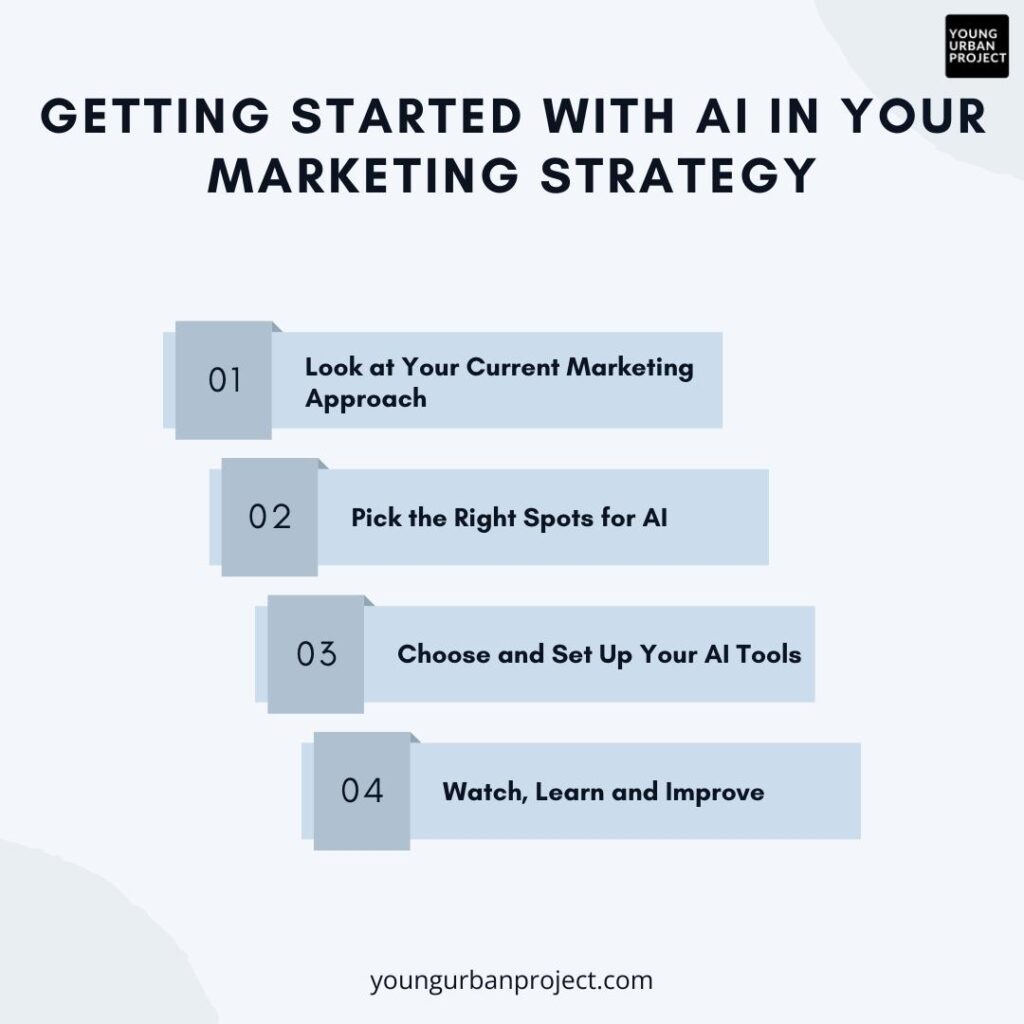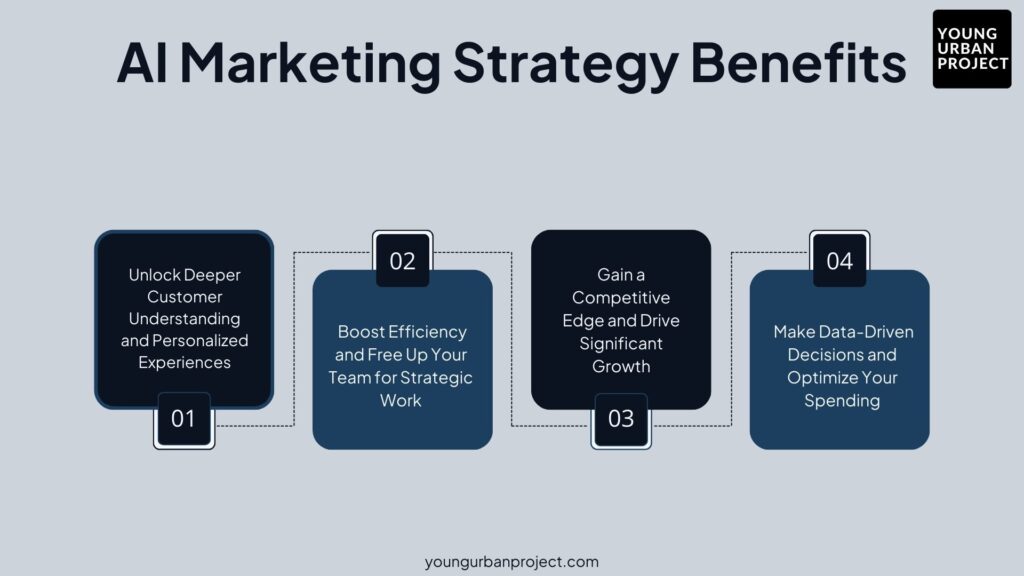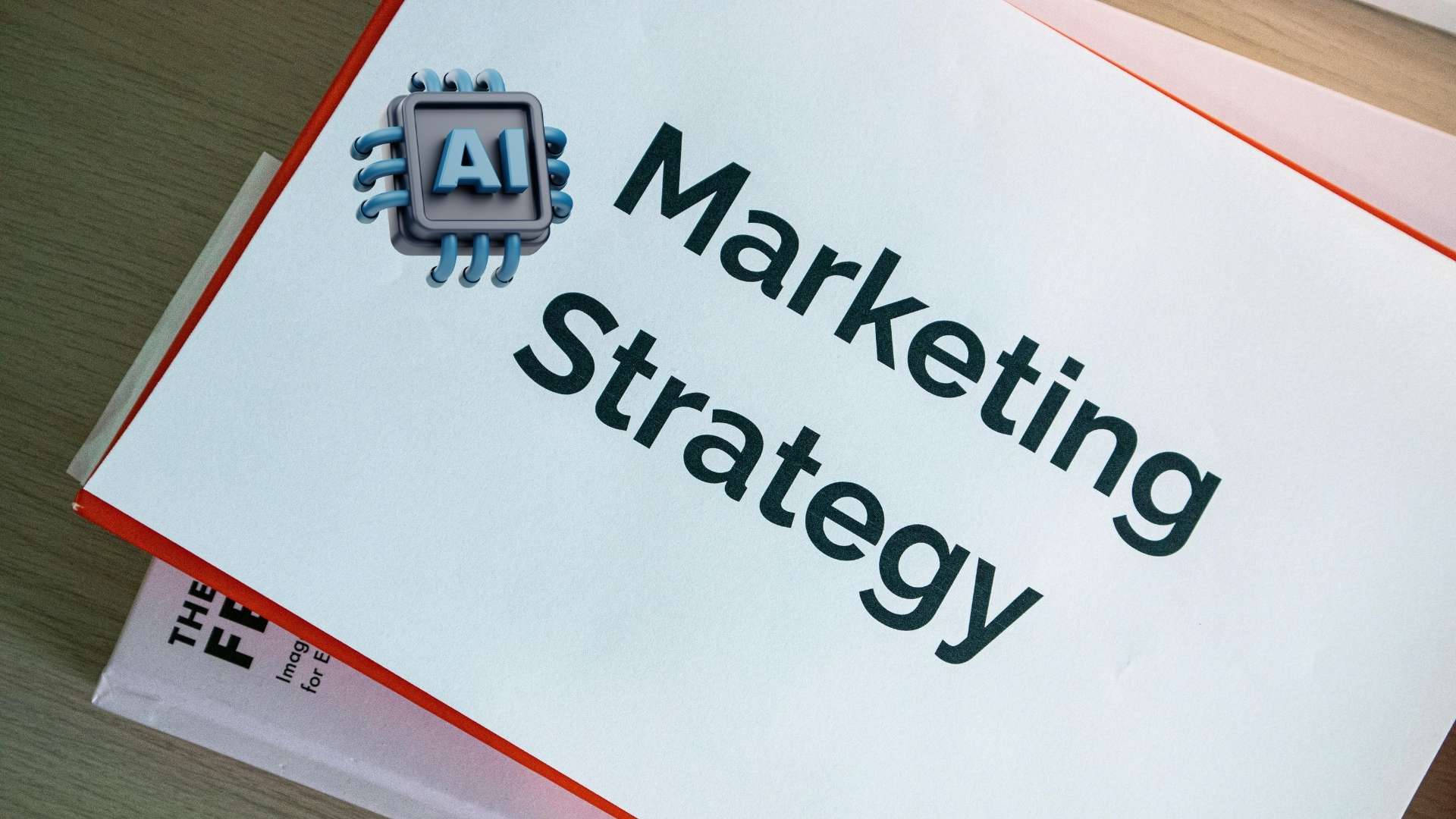Marketing is tough these days. Everyone’s fighting for attention online, and the old ways just don’t cut it anymore. That’s where AI comes in. It’s not just fancy tech – it’s a real game-changer for marketing. This guide explains AI in marketing strategy without the complicated jargon. We’ll show you how it helps understand what customers really want, makes your ads work better, and saves you time on repetitive stuff. You’ll learn about tools that work for any business size, and how to use them even if you’re not tech-savvy. By the end, you’ll see how AI can boost your marketing without breaking the bank.
Table of Contents
What is an AI Marketing Strategy?
An AI marketing strategy means adding smart computer tools to your regular marketing plans. It helps you make better decisions using data instead of just guessing what might work. AI tools can look at customer behavior, predict what they’ll buy next, send automatic emails, and create personalized ads. Unlike old-school marketing that treats everyone the same, AI marketing gives each customer what they want. It saves time by handling boring tasks so your team can focus on creative work. The best part? You spend less money because AI helps you target only the people who actually want your products.
Key Components of AI Marketing Strategy
1. Data Collection and Analysis
AI tools gather info from your website, social media, and sales. They spot patterns humans might miss, like which products sell best on rainy days or which email subject lines get opened most. This helps you make smarter choices based on facts, not hunches.
Also Read: How to Build A Social Media Marketing Strategy in 7 Steps
2. Customer Segmentation
AI splits your customers into specific groups based on what they buy, how often they visit your site, or even what they click on. Instead of treating everyone the same, you can send special offers to different groups. Someone who browses winter jackets gets different ads than someone looking at swimsuits.
3. Personalization
AI remembers what each customer likes and shows them more of it. When someone visits your website, they see products they might actually want instead of random stuff. Netflix suggesting shows you might like or Amazon recommending products works this way – it’s AI picking things just for you.
4. Automation
AI handles repetitive tasks without getting tired. It can answer common customer questions through chatbots, send birthday emails automatically, or post on social media at the best times. Your team doesn’t waste time on boring jobs and can focus on the creative work that robots can’t do.
5. Predictive Analytics
AI looks at past customer behavior to guess what will happen next. It might notice people who buy dog food often buy toys two weeks later, so you can send them a toy coupon at just the right time. It also spots trends before humans notice them, like which products might sell big next month.
6. Programmatic Advertising
AI buys ad space online in real time, faster than any human could. When someone visits a website, AI decides in milliseconds if they match your target customer and how much to bid for that ad spot. This gets your ads in front of the right people at the right price.
7. AI-Powered SEO & Content Strategy
AI tools find the exact words people type when searching for products like yours. They suggest blog topics your customers care about and help write content that ranks well on Google. They also tell you which old content needs updating and what new topics might bring in customers.
Also Read: What is Go-To-Market Strategy
Getting Started with AI in Your Marketing

Step 1: Look at Your Current Marketing Approach
Take a good look at what’s working and what’s not in your marketing right now. Find the tasks that eat up too much time or don’t give good results. Maybe your team spends hours sorting customer data or guessing which email subject lines work best. These problem areas are perfect for AI help. Also, check where you’re missing opportunities – like not knowing enough about what customers want or sending everyone the same message.
- List all your marketing activities
- Note which tasks take the most time
- Identify where results are disappointing
- Look for missed opportunities
Step 2: Pick the Right Spots for AI
Not everything needs AI. Focus on areas where AI can really make a difference. Start with simple stuff like sorting customer lists or scheduling social posts. Content creation is another good spot – AI can help write first drafts or suggest topics. Customer service chatbots can handle basic questions. Ad targeting is perfect for AI since it involves lots of data. Pick just 2-3 areas to start so you don’t get overwhelmed.
- Social media scheduling and monitoring
- Email marketing personalization
- Basic content creation and ideas
- Customer data analysis
- Ad targeting and testing
Also Read: Types of Email Marketing
Step 3: Choose and Set Up Your AI Tools
Pick tools that solve your specific problems, not just the fanciest tech. Start with free versions to test before buying. Make sure the tool fits with what you already use and is easy for your team to learn. Don’t rush this step – ask for demos and trial periods. Once you pick a tool, start small with a test project before going all-in. Get your team trained properly so they actually use the tool.
- Test free versions first
- Make sure tools work with your existing systems
- Check if it’s easy for your team to use
- Start with one small project
- Get proper training for your team
Step 4: Watch, Learn and Improve
Keep a close eye on how your AI tools are working. Set clear goals like “increase email opens by 15%” so you know if AI is helping. Collect feedback from your team about what’s working and what’s not. The beauty of AI is it gets smarter over time if you feed it good data. Be ready to adjust your approach based on results – sometimes the first AI solution isn’t the right one. Keep learning about new AI options as they come out.
- Track specific numbers before and after using AI
- Get regular feedback from your team
- Update your AI tools with new data regularly
- Be willing to switch tools if needed
- Keep learning about new AI marketing options
Why Create an AI Marketing Strategy?
1. Keeping Up With Digital Changes
Marketing is changing fast as new tech comes out. Companies that don’t adapt get left behind. AI isn’t just a fancy add-on anymore – it’s becoming the normal way to do marketing. Big brands are already using AI to reach customers better. If you wait too long to start using AI, you’ll have to work twice as hard to catch up later. It’s like when businesses had to get websites – those who waited lost customers to competitors who moved faster.
2. Growing Without Hiring More People
As your business gets bigger, AI helps you handle more customers without adding lots of staff. Your same team can manage more social accounts, send more emails, and run more ad campaigns with AI helping them. One small business owner said his 3-person team now does work that used to need 7 people, all because AI handles the routine stuff. This lets you grow your business without your marketing costs growing just as fast.
Also Read: Go-To-Market (GTM) Strategy Framework
3. Meeting What Today’s Customers Expect
Today’s consumers expect businesses to anticipate their needs, much like Netflix recommending shows or Amazon suggesting products based on past behavior. Generic marketing no longer works—customers notice when content isn’t relevant and quickly lose interest. AI-powered personalization enables businesses to meet these expectations by delivering tailored experiences. In fact, 76% of consumers feel frustrated when websites fail to provide relevant recommendations based on their past interactions.
(Source: McKinsey)
4. Beating Your Competition
In a competitive market, businesses that embrace AI marketing gain a significant advantage over those relying on traditional methods. AI helps attract more potential customers and improve conversion rates by delivering smarter, data-driven strategies. Over time, even small improvements compound, creating a noticeable gap between businesses that leverage AI and those that don’t. By integrating AI into your marketing, you can stay ahead and build long-term success.
5. Making Smarter Business Choices
Guessing what might work wastes money. AI looks at tons of data to spot patterns humans would miss. It might notice customers who buy product A often buy product B three weeks later – so you can time your marketing perfectly. Before AI, businesses relied on intuition to make decisions. Now, with data-driven insights, they can predict demand more accurately, optimize inventory, and reduce unnecessary spending.
Also Read: Types of Marketing
AI Marketing Strategy Benefits

1. Unlock Deeper Customer Understanding and Personalized Experiences
Smart marketing tools help you learn what your customers really want. They track which products people look at and what they buy. This lets you show customers more of what they like instead of random offers. When marketing feels made just for them, people pay more attention and buy more often.
2. Boost Efficiency and Free Up Your Team for Strategic Work
Marketing tools handle boring tasks that eat up your team’s time. They can send emails, post on social media, and sort customer data automatically. This means your team can focus on big-picture planning instead of repetitive tasks. You can run more campaigns without hiring more people.
3. Gain a Competitive Edge and Drive Significant Growth
While other businesses use outdated marketing methods, you can stay ahead by using tools that target the right customers with the right messages. This helps you find new customers faster and keep existing ones longer. Businesses using smart marketing often grow faster than those stuck in old ways.
4. Make Data-Driven Decisions and Optimize Your Spending
Stop guessing what might work and wasting money on ads that don’t deliver. Marketing tools show exactly which efforts bring in customers and which don’t. They help you spend less on campaigns that aren’t working and more on ones that are. This means better results without bigger budgets.
Limitations of AI Marketing
1. Privacy Worries
Customers get concerned about how their data is used. They want personalized experiences but also worry about their information being collected. Finding this balance is tricky. You need clear policies explaining what data you collect and how you use it. One company lost customer trust after their AI system seemed to know too much personal information, making people uncomfortable with how much was being tracked.
2. Getting Everything Working Together
Making new AI tools work with your existing systems can be a headache. Your email platform might not connect easily with your AI customer analysis tool. This creates extra work moving data between systems. One marketing team spent three months and thousands of dollars getting their AI tools to properly talk to their older customer database before seeing any benefits.
3. Teaching Your Team New Skills
Many marketing people weren’t trained on AI tools. They might resist using new systems or not understand how to get the most from them. Training takes time and some staff might worry AI will replace their jobs. One agency reported spending 40+ hours per employee on training before their team felt comfortable using their new AI marketing systems effectively.
4. Trusting The Black Box
AI sometimes makes recommendations without explaining why. This makes marketers uncomfortable when they can’t see the reasoning behind suggestions. If results don’t match expectations, it’s hard to know what went wrong or how to fix it. One company followed their AI’s suggestion to shift budget to a new channel, only to see poor results because the AI had limited data to work with initially.
5. Keeping The Human Touch
When marketing gets too automated, it can feel robotic and cold. Customers still want to feel a human connection to brands they buy from. Finding the right mix of AI efficiency and human creativity is challenging. One brand’s fully AI-generated email campaign technically performed well but received customer feedback saying the communications felt “soulless” and “like talking to a machine.”
Also Read: Importance Of Marketing
Best AI Marketing Tools
Harnessing AI doesn’t require a tech degree. Simple tools are emerging to boost your marketing. Discover platforms that analyze customer data, automate tasks, and personalize content – all designed to save you time and money while connecting better with your audience. Let’s explore some accessible AI Marketing Tools options.
1. AI-Powered Analytics Platforms – Google Analytics, HubSpot
These platforms gather data from your websites and campaigns, then organize it into understandable reports. They show you which marketing efforts are working and which aren’t, saving you from guessing. Analytics platforms help you make decisions based on actual customer behavior rather than hunches.
Key Features:
- Track visitor actions on your website
- See which marketing channels bring the most customers
- Measure conversion rates for different audience segments
- Create custom reports without needing technical skills
- Get alerts when metrics change significantly
2. AI-Powered CRM Systems – Salesforce, Zoho AI
Customer Relationship Management systems keep track of all your customer interactions in one place. They help sales teams know when to follow up and what to say. Modern CRMs use smart technology to suggest which leads to focus on first and what products to recommend.
Key Features:
- Store all customer data and conversations in one place
- Score leads based on likelihood to purchase
- Remind sales teams when to follow up with prospects
- Track the entire customer journey from first click to purchase
- Predict which customers might stop buying soon
3. Content Creation Tools – Jasper, Copy.ai
These tools help marketers write more content faster. They can suggest ideas, create first drafts, and help polish your writing. While they won’t replace good writers, they can handle routine writing tasks and help overcome writer’s block.
Key Features:
- Generate blog topic ideas based on keywords
- Create first drafts of emails and social posts
- Rewrite content for different audiences
- Suggest headlines that get more clicks
- Check tone and readability of your writing
4. Chatbots & Virtual Assistants – Drift, ChatGPT
Chatbots answer common customer questions instantly, 24 hours a day. They handle simple requests so your team can focus on complex issues. Good chatbots can understand questions asked in different ways and provide consistent answers.
Key Features:
- Answer basic customer questions any time of day
- Qualify leads by asking important questions
- Book meetings without human involvement
- Transfer to human agents for complex questions
- Learn from past conversations to improve over time
5. AI SEO & Keyword Tools – Surfer SEO, Clearscope
These tools help your content rank higher in search results. They analyze top-performing pages and suggest words to include in your content. They also help structure your writing in ways search engines prefer.
Key Features:
- Find keywords your competitors are missing
- Check if your content covers topics thoroughly
- Suggest ways to improve existing content
- Track ranking changes over time
- Identify content gaps in your overall strategy
Also Read: Technical SEO Checklist: 10 Key Steps (+5 Expert Tips!)
6. Programmatic Advertising Platforms – Google Ads AI, Adzooma
Programmatic platforms buy ad space automatically based on who’s viewing a webpage. They make thousands of decisions per second about where your ads should appear. These tools help your budget go further by showing ads only to people likely to be interested.
Key Features:
- Buy ad placements across many websites automatically
- Target ads based on user behavior and interests
- Adjust bids in real-time based on likelihood of conversion
- Stop showing ads to people who aren’t responding
- Test different ad versions to see which works best
Case Studies of AI in Marketing
1. Delta Air Lines – AI-powered ad performance tracking

Delta Airlines uses advanced analytics technology to monitor how their digital advertisements perform across different platforms. Their system helps track the customer journey from initial ad exposure through to booking completion. This approach allows Delta to understand which marketing channels and messages are most effective at converting viewers into actual ticket purchasers.
Key Points:
- Improved allocation of marketing budget by identifying high-performing ad placements
- Better understanding of the customer booking journey across multiple touchpoints
- Ability to distinguish between effective marketing for different customer segments
- Enhanced targeting capabilities based on customer behavior patterns
- More efficient marketing spend through data-driven decision making
2. Yum Brands (Taco Bell, KFC) – AI-driven campaign optimization

Yum Brands implements data-driven marketing strategies across their restaurant chains including KFC and Taco Bell. Their approach involves testing multiple marketing variables simultaneously and using automated systems to optimize campaigns based on real-time performance data. This helps them quickly identify which promotions resonate with customers in different locations and contexts. (Source)
Key Points:
- Automated testing of different promotional messages and creative elements
- Dynamic budget allocation to highest-performing marketing channels
- Location-specific marketing based on local customer preferences
- Menu recommendation systems that adapt to customer ordering patterns
- Improved promotional targeting based on various factors including time and location
3. Chadstone Shopping Centre – AI-powered food concierge service

Chadstone Shopping Centre implemented a digital solution to enhance the dining experience for shoppers. Their food concierge system helps visitors discover dining options that match their preferences, dietary requirements, and other criteria. The service aims to improve customer satisfaction while providing valuable insights about food preferences.
Key Points:
- Digital assistance for helping shoppers find suitable dining options
- Personalized recommendations based on individual preferences and requirements
- Streamlined information access about restaurant options, menus, and locations
- Enhanced shopping experience through convenient food-finding capabilities
- Data collection on customer preferences to inform future retail planning
Enroll Now: Live Advanced Digital Marketing Course
Conclusion
AI isn’t magic, but it sure helps with marketing. Start small – pick one problem and find an AI tool that fixes it. You don’t need a computer degree to get results. These tools help you figure out what customers want, make better content, and spend your money smarter. The marketing world keeps changing, but knowing your customers never goes out of style. Businesses that try AI now will stay ahead of competitors who don’t. The best part? Many tools are affordable or even free to start. Take what you’ve learned here and give it a shot – your business will thank you.
FAQs: AI in Marketing Strategy
1. Is AI marketing only for big companies with large budgets?
No, even small businesses can now use these smart marketing tools. Many are affordable and some even have free versions. Start small with basic tools that help schedule social media posts or group your customers, and see how they work before spending more.
2. Do I need to be a tech expert to use AI marketing tools?
Not at all. Most of these marketing tools are designed to be easy to use, with simple layouts and helpful guides. While you might need to practice a bit with some tools, you don’t need to be tech-savvy to get good results. Just pick tools that your team can easily learn.
3. Will AI replace human marketers?
No. While these tools are great at handling data, automating tasks, and personalizing messages, they can’t match human creativity, understanding, or strategic thinking. Think of these tools as helpers that free up your time for the creative and planning parts of marketing.
4. How can I ensure I’m using AI ethically in my marketing?
Be open about how you collect and use customer information. Don’t use these tools in ways that could discriminate against people or reinforce unfair views. Regularly check your systems to make sure they’re fair and respect customer privacy.
5. What are some easy ways for a beginner to start using AI in marketing?
Start simple. Try using Google Analytics to understand your website visitors, add a simple chat helper to your website for customer questions, or use tools that post on social media at the best times. These are safe ways to see the benefits.
6. How do I measure the success of my AI marketing strategy?
Set clear goals and track numbers that matter to those goals. If you’re personalizing emails, look at how many people open them and click links. If you’re targeting ads, watch how many people buy something and what it costs to get each customer. Check these numbers regularly to see what’s working and make changes as needed.

